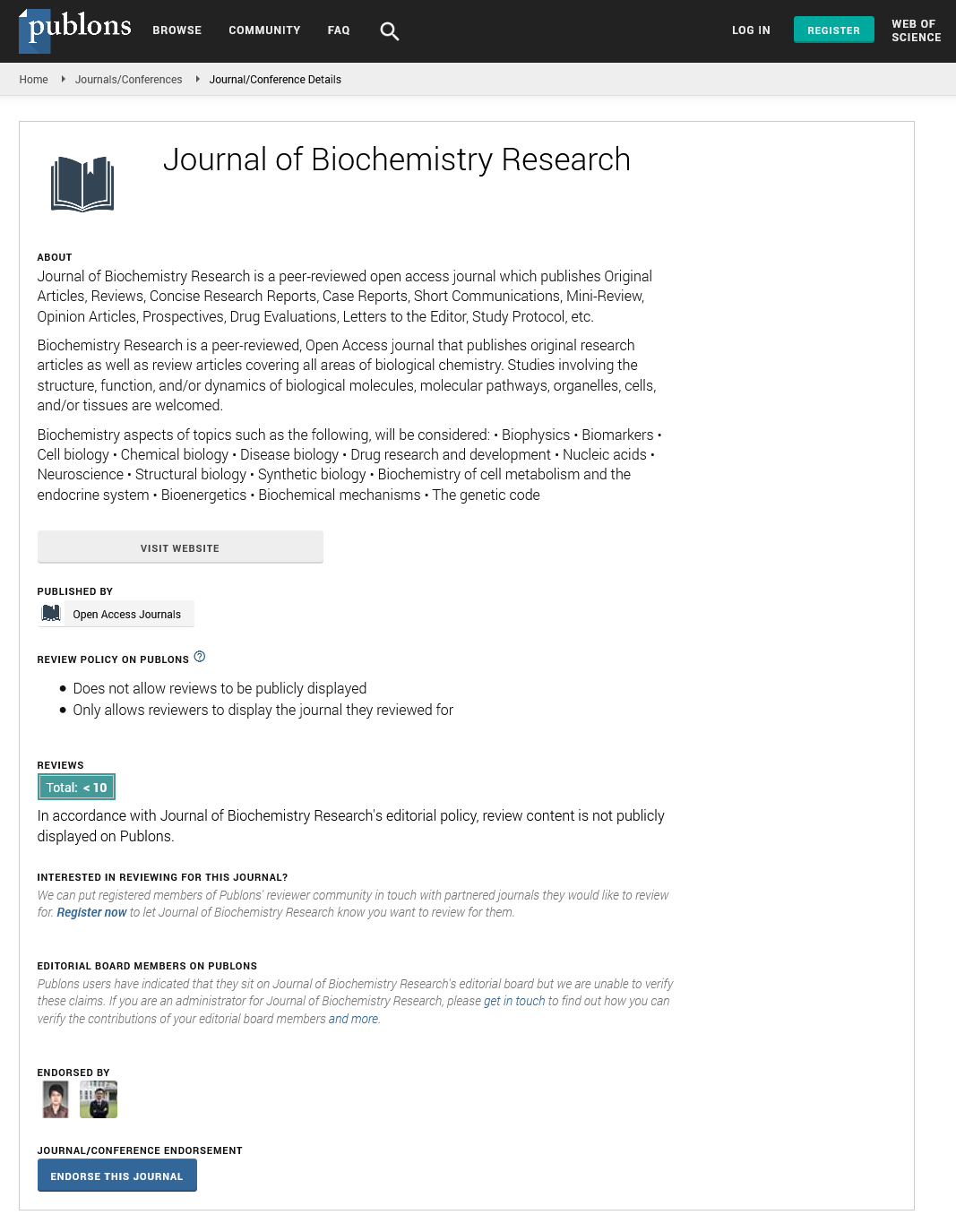Editorial - Journal of Biochemistry Research (2023) Volume 6, Issue 3
Cellular Components: Proteins and Their Crucial Role in Cell Function
Bin cao*
College of Computer Science Department of biochemistry University of Australia
College of Computer Science Department of biochemistry University of Australia
E-mail: binc@gmail.com
Received: 02-06-2023, Manuscript No. oabr-23-101503; Editor assigned: 05-06-2023, Pre QC No. oabr-23- 101503; Reviewed: 19-06-2023, QC No. oabr-23-101503; Revised: 22-06- 2023, Manuscript No. oabr-23-101503 (R); Published: 29-06-2023; DOI: 10.37532/oabr.2023.6(3).55-57
Abstract
Proteins are fundamental cellular components that play a crucial role in maintaining cell structure and function. This article provides an in-depth exploration of proteins, focusing on their diverse functions and their significance in various cellular processes. The structure of proteins, including primary, secondary, tertiary, and quaternary structures, is discussed, highlighting the importance of protein folding and organization. The process of protein synthesis, from transcription to translation, is outlined to provide a comprehensive understanding of how proteins are produced in cells. The article then explores the wide range of functions performed by proteins, including enzymatic activity, structural support, transport and communication, immune defense, and signaling and regulation. Understanding the role of proteins in cellular processes is essential for advancing our knowledge of cell biology and its implications in health and disease.
Keywords
Proteins • Cellular components • Cell function • Protein structure • Protein synthesis • Enzymatic activity • Structural support • Transport and communication
Introduction
Proteins, as cellular components, are indispensable for the proper functioning of cells. These complex molecules are involved in a wide array of cellular processes, ranging from maintaining cell structure and providing mechanical support to facilitating chemical reactions and regulating communication between cells [1]. Understanding the role of proteins in cellular function is crucial for unraveling the complexities of cell biology and advancing our knowledge of health and disease [2]. In this article, we will delve into the fascinating world of proteins, exploring their diverse functions and highlighting their significance in various cellular processes [3]. Within the intricate world of cellular biology, proteins stand out as vital components that are responsible for carrying out a myriad of essential functions [4]. These complex molecules play a critical role in maintaining cell structure, enabling communication between cells, facilitating chemical reactions, and regulating various cellular processes [5]. In this comprehensive article, we will delve into the fascinating realm of proteins, exploring their diverse functions and highlighting their significance in cellular processes [6]. Proteins are fundamental cellular components that play crucial roles in various biological processes [7]. These complex molecules are involved in almost every aspect of cellular function, from maintaining cell structure to facilitating chemical reactions and signal transduction. In this article, we will explore the diverse functions of proteins and their importance in cellular processes [8]. The functions of proteins are incredibly diverse. They act as enzymes, catalyzing chemical reactions necessary for metabolism and cellular processes. Enzymes accelerate the rate of reactions by lowering the activation energy required for the reaction to occur. Additionally, proteins provide structural support, maintaining cell shape and integrity [9]. They form the cytoskeleton, a dynamic network of protein filaments that contributes to cellular movement, division, and organization. Proteins are involved in cellular signaling, allowing cells to communicate with one another and respond to external stimuli. Receptor proteins on the cell surface recognize and bind to specific molecules, initiating a cascade of events that transmit signals and trigger appropriate cellular responses. Proteins also play a critical role in transporting molecules across cell membranes and within the cell, facilitating the movement of nutrients, ions, and signaling molecules. Furthermore, proteins are integral to the immune system, participating in immune defense mechanisms. Antibodies, which are specialized proteins, recognize and neutralize pathogens, preventing infections [10]. Proteins are also involved in gene expression regulation, controlling when and how genes are transcribed into RNA and translated into proteins, thereby influencing cellular identity and function.
Materials and Methods
Protein isolation and purification
Cell culture: Cells of interest (e.g., bacterial, mammalian, yeast) are cultured in appropriate growth media under controlled conditions (e.g., temperature, pH, CO2 concentration) to promote protein production.
Cell lysis: Cells are harvested and lysed using techniques such as sonication, freeze-thaw cycles, or chemical lysis to release cellular contents, including proteins.
Protein extraction: Proteins are extracted from the cellular lysate using buffers optimized for solubilizing and stabilizing proteins.
Protein purification: Various purification techniques are employed to separate the target protein from other cellular components. These techniques may include chromatography (e.g., affinity chromatography, ion exchange chromatography), electrophoresis (e.g., SDSPAGE), and filtration.
Protein characterization and analysis
Protein concentration determination: Protein concentration is measured using methods such as Bradford assay, BCA assay, or UV spectroscopy.
Protein size and purity analysis: SDS-PAGE is performed to determine protein size and purity by separating proteins based on their molecular weight.
Western blotting: This technique is used to detect and quantify specific proteins of interest using antibodies that bind to the target protein.
Mass spectrometry: Proteomic analysis techniques, including liquid chromatographymass spectrometry (LC-MS), are used to identify and characterize proteins based on their mass and peptide sequences.
Protein structure analysis: Techniques such as X-ray crystallography, nuclear magnetic resonance (NMR) spectroscopy, or cryoelectron microscopy (cryo-EM) are employed to determine the three-dimensional structure of proteins.
Structure of proteins: Proteins, composed of amino acids, possess a complex and highly organized structure that is crucial to their function. The primary structure of a protein refers to the linear sequence of amino acids, which is dictated by the genetic information encoded in DNA. The sequence of amino acids determines the unique characteristics and properties of each protein. As proteins fold, they acquire a secondary structure, which can include alpha helices, beta sheets, or random coil regions. The tertiary structure represents the overall three-dimensional arrangement of the protein, formed by interactions between amino acid residues. Some proteins can further assemble into quaternary structures, in which multiple polypeptide chains come together to form a functional unit.
Protein synthesis: The synthesis of proteins, known as protein synthesis or translation, is a complex process that involves multiple steps. It begins with transcription, during which the genetic information stored in DNA is transcribed into messenger RNA (mRNA) molecules by the enzyme RNA polymerase. The mRNA molecules then travel from the nucleus to the cytoplasm, where they serve as templates for protein synthesis. Ribosomes, composed of ribosomal RNA (rRNA) and various proteins, bind to the mRNA molecules and facilitate the translation process. Transfer RNA (tRNA) molecules bring the corresponding amino acids to the ribosome, where they are joined together to form a polypeptide chain. This chain undergoes folding and post-translational modifications to achieve its final functional form.
Functions of proteins
Enzymes: Proteins serve as catalysts, accelerating chemical reactions in cells by lowering the activation energy required. Enzymes are involved in almost every metabolic pathway, facilitating processes such as digestion, energy production, and DNA replication. Examples of enzymes include amylase, which aids in the breakdown of carbohydrates, and DNA polymerase, responsible for DNA replication.
Structural support: Proteins contribute to the structural integrity of cells and tissues. The cytoskeleton, composed of various proteins such as actin and tubulin, provides mechanical support, maintains cell shape, and enables cell movements. Additionally, proteins like collagen and elastin form the extracellular matrix, giving strength, elasticity, and structure to tissues such as skin, tendons, and bones.
Transport and communication: Proteins play a crucial role in transporting molecules across cell membranes and throughout the body. For instance, channel proteins facilitate the passage of ions and small molecules across the cell membrane, ensuring proper cellular function. Carrier proteins selectively bind to specific molecules and transport them across membranes. Membrane receptors, another type of protein, allow cells to communicate with their environment by recognizing and binding to signaling molecules such as hormones.
Immune defense: The immune system relies on proteins to defend the body against pathogens and foreign substances. Antibodies, also known as immunoglobulins, are specialized proteins produced by white blood cells that recognize and neutralize specific antigens, such as viruses or bacteria. Additionally, proteins like cytokines and chemokines regulate immune responses and facilitate communication between immune cells.
Conclusion
Proteins are essential cellular components that underpin the intricate machinery of life. Their multifaceted functions contribute to maintaining cell structure, enabling communication between cells, facilitating chemical reactions, and regulating various cellular processes. From enzymatic activity to structural support, transport and communication, immune defense, and signaling and regulation, proteins play a pivotal role in every aspect of cell function. By elucidating the structure and function of proteins, we gain valuable insights into the inner workings of cells, paving the way for advancements in biomedical research, disease understanding, and the development of novel therapeutic strategies. The continued exploration of proteins and their role in cellular processes holds the potential to revolutionize our understanding of life and unlock new avenues for improving human health.
References
- Bianconi, Piovesan, Allisonet et al. An estimation of the number of cells in the human body. Ann Hum Bio. 40, 463-471 (2013).
- Azevedo FA, Carvalho LR, Grinberg LT et al. Equal numbers of neuronal and nonneuronal cells make the human brain an isometrically scaled-up primate brain. J Comp Neurol.513, 532-541 (2009).
- Satir P, Christensen ST. Structure and function of mammalian cilia. Histochem Cell Biol.129, 687-693 (2008).
- Blair DF, Dutcher SK. Flagella in prokaryotes and lower eukaryotes. Curr Opin Genet Dev. 2,756-767(1992).
- Griffiths G. Cell evolution and the problem of membrane topology.Cell Biology. 8, 1018-1024 (2007).
- Schopf JW. Fossil evidence of Archaean life. Series B Biological Sciences. 361, 869-885 (2006).
- Orgel LE.The origin of life--a review of facts and speculations. Trends Biochem Sci. 23, 491-495 (1998).
- Popper ZA, Michel G, Hervé C et al. Evolution and diversity of plant cell walls: from algae to flowering plants. Annu Rev Plant Biol. 62,567-590 (2011).
- Ananthakrishnan R, Ehrlicher A.The forces behind cell movement. Int J Biol Sci.3, 303-317(2007).
- Michie KA, Löwe J.Dynamic filaments of the bacterial cytoskeleton. Annu Rev Biochem.75, 467-492(2006).
Indexed at, Google Scholar, Crossref
Indexed at, Google Scholar, Crossref
Indexed at, Google Scholar, Crossref
Indexed at, Google Scholar, Crossref
Indexed at, Google Scholar, Crossref
Indexed at, Google Scholar, Crossref
Indexed at, Google Scholar, Crossref
Indexed at, Google Scholar, Crossref
Indexed at, Google Scholar, Crossref


